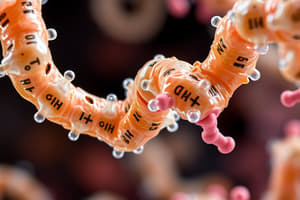Podcast
Questions and Answers
Enzyme-controlled reactions are affected by ______ and pH.
Enzyme-controlled reactions are affected by ______ and pH.
temperature
Above ______ degrees, the rate of reaction drops rapidly due to enzyme denaturation.
Above ______ degrees, the rate of reaction drops rapidly due to enzyme denaturation.
37
Each enzyme has an ______ temperature where the rate of reaction is highest.
Each enzyme has an ______ temperature where the rate of reaction is highest.
optimal
Enzymes have an ______ pH at which they work best, depending on their usual environment.
Enzymes have an ______ pH at which they work best, depending on their usual environment.
Signup and view all the answers
What happens to the rate of an enzyme-controlled reaction as temperature increases initially?
What happens to the rate of an enzyme-controlled reaction as temperature increases initially?
Signup and view all the answers
Why does the rate of an enzyme-controlled reaction drop rapidly above 37°C?
Why does the rate of an enzyme-controlled reaction drop rapidly above 37°C?
Signup and view all the answers
How can pH levels affect the rate of an enzyme-controlled reaction?
How can pH levels affect the rate of an enzyme-controlled reaction?
Signup and view all the answers
Give an example of an optimal pH for an enzyme based on its environment.
Give an example of an optimal pH for an enzyme based on its environment.
Signup and view all the answers
What term describes the phenomenon where an enzyme becomes permanently inactivated by high temperatures?
What term describes the phenomenon where an enzyme becomes permanently inactivated by high temperatures?
Signup and view all the answers
Study Notes
- Enzyme-controlled reactions are affected by temperature and pH.
- Temperature: Initially, as temperature increases, the rate of reaction increases due to increased kinetic energy of particles. However, above 37 degrees, the rate drops rapidly as high temperatures break enzyme bonds, leading to denaturation around 45 degrees.
- Optimum temperature: Each enzyme has an optimal temperature where the rate of reaction is highest, for example, 37 degrees in this case.
- pH: pH levels that are too high or too low can lower the rate of reaction by breaking enzyme bonds and changing the shape of the active site.
- Optimal pH: Enzymes have an optimal pH at which they work best, depending on their usual environment; for example, enzymes in the stomach work best at a pH of around two.
Studying That Suits You
Use AI to generate personalized quizzes and flashcards to suit your learning preferences.
Description
Explore how enzyme-controlled reactions are influenced by temperature and pH. Learn about how temperature affects enzyme activity, the concept of optimum temperature, the impact of pH levels on enzyme function, and the idea of optimal pH for different enzymes.





